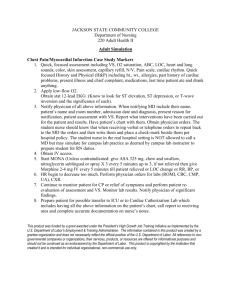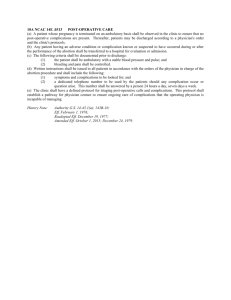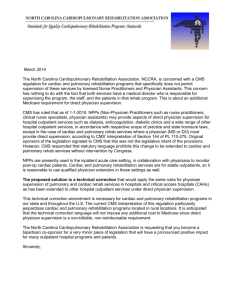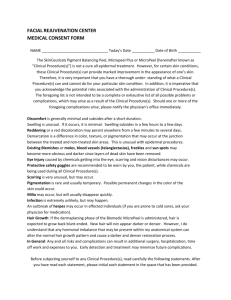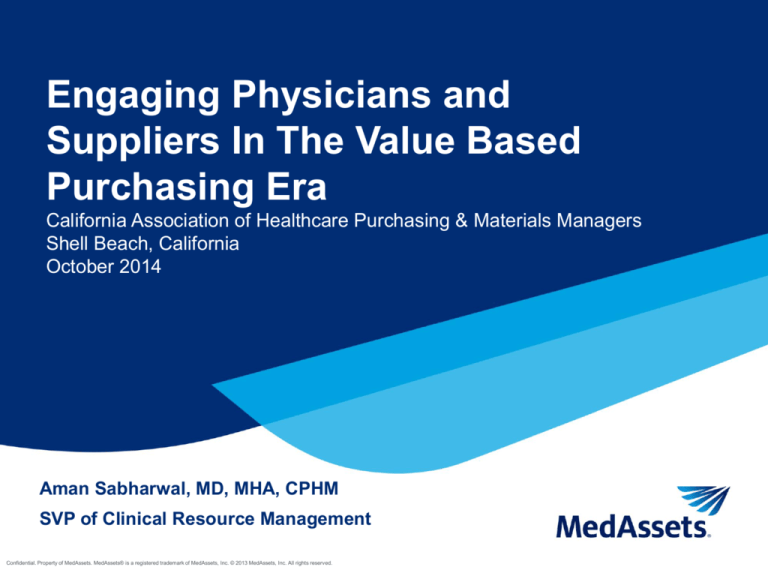
Engaging Physicians and
Suppliers In The Value Based
Purchasing Era
California Association of Healthcare Purchasing & Materials Managers
Shell Beach, California
October 2014
Aman Sabharwal, MD, MHA, CPHM
SVP of Clinical Resource Management
1
Confidential. Property of MedAssets. MedAssets® is a registered trademark of MedAssets, Inc. © 2013 MedAssets, Inc. All rights reserved.
Introductions
• Aman Sabharwal, M.D., M.H.A., CPHM
– SVP Clinical Resource Management, MedAssets
– Practicing Hospitalist
– Clinical Assistant Professor of Medicine
– University of Miami Miller School of Medicine
– Florida International University College of Medicine
– 14+ years healthcare experience
– Areas of expertise
– Clinical Efficiency
– Quality & Utilization
2
Impact of Healthcare Reform
3
2009
2010
2011
2012
2013
2014
2015
CMS - from Fee For Service Volume Model Transition to…..Value – High Quality/ Low Cost
EMR/Meaningful
Use
Healthcare Reform 3/2010
PHASE
1
PHASE
2
PHASE
3
Implement expanded insurance coverage, Medicaid expansion.
Health Insurance
Exchanges Data
Value Based Purchasing Yr
1 –F2013 on F2012
Performance.
Value Based Purchasing Continues.
Penalties and Rewards increase for Quality
Performance.
Comparative Effectiveness
Accountable Care
Organization Program Jan
2012
Payment Bundling Pilot Program Jan 2013
30 Day Readmits Program FY2013
ICD10 Compliance – 10/2014 ?
Hospital Acquired Conditions Program
F2015. Readmission Reduction Program
4
Value Based Purchasing
• Required by Congress under Section 1886(o) of the Social Security Act
• Next step in promoting higher quality care for Medicare beneficiaries
• CMS views value-based purchasing as an important driver in revamping how
care and services are paid for, moving increasingly toward rewarding better
value, outcomes, and innovations instead of volume
• Legislation requires that the FY 2013 Hospital VBP program apply to payments
for discharges occurring on or after October 1, 2012
• Hospital VBP measures must be included on Hospital Compare website for at
least one year and specified under the Hospital IQR program
5
5
Value Based Purchasing
• VBP was established by the Affordable Care Act of 2010 (ACA)
• Budget neutral payment changes begin October 1, 2012
• Physician payment changes begin January 1, 2015
• Rewards for achievement or improvement
6
6
Impact on Hospitals
7
7
Imperatives for Hospital’s Future Success
• Manage costs to reimbursement
– Educating providers about margin
– Educating providers about reimbursement schemes
• Align incentives for hospital, physicians and non-acute providers
(preparation for ACO)
• Migrate from fee-for-volume to fee-for-quality
– Value Based Purchasing
• Focus on chronic disease management
– Bundled payments
– Episodes of care
*Source: Modern HC 6-29-09, pg 16 MEDPAC. FierceHealthFinance, 12-15-09
8
Value-Based Purchasing
• Congress authorized CMS to reduce the reimbursement of over 3,000
hospitals in the Affordable Care Act to reinforce improving healthcare
quality, including the patient experience and efficiency.
• Hospitals have an incentive to improve quality and earn the
reimbursement back by achieving higher than average quality scores.
• Simply stated, hospitals with below average quality provide the incentive
pool via CMS fund the bonus payments for those above average.
• This money is then redistributed to hospitals based on the quality of
care.
9
Source: CMS QualityNet
Reimbursement @ Risk Increases Annually
+ Incentives Lost to Competitors Add to Cost of Poor Quality
Reimbursement at Risk from CMS VBP, Excess Readmissions, Healthcare
Acquired Conditions Reduction Program
7%
6%
5%
4%
3%
2%
1%
0%
2013
2014
VBP Holdback
10
2015
Excess Readmissions
2016
HAC Reduction
2017
Funding Value Based Purchasing
11
11
Earning Your Score
• Achievement or Improvement
– Achievement 0-10 points
– Improvement 0-9 points
– Highest of either score used
• Achievement Points
– Must meet threshold (performance at 50th percentile)
– Based on where performance falls
• Improvement Points
– Performance compared to baseline
– CMS: no full credit for improvement
12
12
FY 2013 Domains & Measures
13
13
Eligibility for VBP Measures
• Hospitals with at least 10 cases for at least 4 applicable measures
during the performance period receive a Clinical Process of Care
score
• Hospitals with at least 100 Hospital Consumer Assessment of
Healthcare Providers and Systems (HCAHPS) surveys during the
performance period receive a Patient Experience of Care score
14
14
Who Gets Impacted
Dotplot of Total Performance Score
Hospital A
receives payment
incentive
Hospital B
loses 1%
M
e
d
i
a
n
14
28
42
56
70
Total Performance Score
Hospital C
receives payment
incentive
84
98
HPP calculated TPS using CMS official published multiplier for fiscal year 2013.
Each symbol represents up to 5 observations.
15
15
FY 2013 Timeline
Final Payment
Adjuster Delivered
Estimated Payment
Adjuster Delivered
Aug Nov
2009
July
2010
March
FY 2013 Baseline Period
16
2011
July
2012
2013
March
FY 2013 Performance Period
16
FY 2014 Domains & Measures
17
17
FY 2014 Timeline
2009
2010
April
December
FY 2014 Baseline Period
18
2011
2012
April
2013
December
FY 2014 Performance Period
18
FY 2015 Domains & Measures
1. MSBP-1. Medicare
Spending Per
Beneficiary (MSPB)
Measure
19
19
FY 2015 Patient Safety Composite Index
20
20
FY 2015 Timeline
2009
2010
2011
Various
Various
FY 2015 Baseline Period
21
2012
2013
Various December
FY 2015
Performance
Period
21
FY 2016 Domains & Measures
22
22
FY 2016 Timeline
2010
October
2011
July
FY 2016 Baseline Period
23
2012
October
2013
2014
January
FY 2016 Performance Period
23
July
What’s New for FY 2015-2017?
• Readmission Reduction Program
– 2013
AMI, Pneumonia, Heart Failure
– 2015
COPD, Total Hip Replacement, Total Knee Replacement
• Hospital Acquired Condition (HAC) Reduction Program
– In tandem with the Value Based Purchasing Program (VBP)
– Top 25% for HAC rates will receive a 1% reduction in their overall
Medicare reimbursement rate
24
CMS Hospital Acquired Condition Reduction Program
25
Impact on Physicians
26
26
Impact on Physicians
• Streamlined insurance claims
processing
– Reduces physician practice
overhead
• 10% incentive Medicare
payment for PCP
• 10% incentive Medicare
payment for Gen Surgeon in
rural setting
• 5% incentive for mental health
services
• Increases Medicaid payments
to PCP to Medicare level
• Extends PQRS
• Value-Based Payment Modifiers
• Expands preventive and
screening benefits
• Transparency
– Drug/device company disclosures
– Limits on physician owned hospital
• Funding to test medical liability
reforms
– Ex: health courts and disclosure
laws
27
27
Eligible Practitioners (PQRS)
28
28
Value-Based Physician Payments Modifier
• Section 3007 of the Affordable Care Act mandate
– CMS applies a value modifier under the Medicare Physician Fee Schedule
(MPFS)
– Both cost and quality data are to be included in calculating payments for
physicians
• Value Modifier
– Physician or group differential payments based on quality and cost of care
delivered (PQRS)
– Rewards practitioners for doing the “right thing” for the patient
• Timeline
– Differential payments begin CY 2015
– Performance periods begin CY 2013
29
29
Physician Domains & Measures
30
Physician Modifier Penalties & Incentives
• Penalties used to cover incentive payments
– 1.5% penalty 2015; 2% penalty 2016
– Groups >100 must register PQRS to avoid additional 1% penalty
• Eligible for an additional +1.0x - +2.0x if:
– Reporting criteria are met
– Scores are in the top 25th percentile
• Example: IF payment adjustment factor (x) is 0.75%:
– High quality/low cost groups of physicians could receive a 1.5% (2 x 0.75) upward payment
adjustment
31
31
Synergies Exist Between All Hospital and Physician
Domains
Cost
Composite
Score
Medicare
Spending per
Beneficiary
32
32
Key Approaches to Engaging Physicians
• Position physician champions to lead clinical initiatives by…
–
–
–
–
–
33
Clinical leadership and accountability
Oversight and initiative direction
Allowing for interpretation of quality and cost per case data
Determining key areas of focus for appropriate clinical resource utilization
Enhancing physician knowledge and skills
Role Of The Suppliers
34
How Can Suppliers Partner with Health Systems and
Providers to Drive Quality?
• What products do suppliers have that can improve:
–
–
–
–
–
–
Patient Safety
Quality of Care
Length of Stay
Readmission
Hospital Acquired Conditions
Patient Satisfaction
• What products do we have that may have secondary advantages to
benefit hospitals under the ACA/VBP/HAC/Readmission Programs?
35
Supplier Innovations Support Quality Improvement
• Nutritional Support protocols have proven to reduce Length of Stay
• Suppliers can add features to urinary catheter kits to make it easier for care
givers to remove the catheters proven to reduce infection
• Coronary Artery Bypass Graft surgical site infections could be reduced with
easier to understand medication and dosing
• Electronic Health Records software has been modified to simplify use of
correct order sets and reminders to caregivers making the core measures
easier to achieve 100% compliance
• We need to capture the resources of our suppliers to improve quality
• Supplier Resource Management - NOT just purchasing
• Suppliers need to think in an innovative fashion and promote themselves in
this arena – we need to be asking them the questions!
36
Surgical Care Improvement
Through Nutritional Optimization
37
Surgical Complications
• SSI are #1 Hospital Acquired Condition1
• Infections are #1 cause of morbidity after surgery1
• Infections prolong hospital stays2
• Infections increase US healthcare costs by ~$10B annually3
• Surgical stress predisposes patients to immune dysfunction5
– Increases risk of infection
– More so when malnourished
• Various nutrient and nutritional strategies have been studied to
evaluate their effect on immune function & clinical outcomes (Drover,
et al)
38
What Is Arginine?
• Amino acid involved in multiple metabolic processes
• Precursor of polyamines and hydroxyproline10
– Connective tissue repair
• Precursor of nitric oxide10
– Signaling molecule
• Essential metabolic substrate for immune cells and required for normal
lymphocyte function11
• Deficiency occurs after surgical stress11,12
– Mechanisms unknown
• Meta-analysis of RCTs evaluating perioperative arginine in elective
surgical patients showed a statistically significant reduction in infectious
complications and shorter LOS
– No overall effect on mortality
39
Types of Elective Surgical Cases (RCTs)
• Upper GI Malignancy
• Lower GI Malignancy
• Pancreatic Malignancy
• Other Elective GI Surgery (Upper and Lower)
• Head & Neck Malignancy
• GYN Malignancy
• Cardiac Surgery
40
Elective GI Malignancy Surgery
• Patients with complications following surgery for GI Cancer had a
mean additional hospital cost of $21,490 per stay vs. pateints without
complications
• Having postop complications increases readmission by a factor of
4.2x
• Having postop complications increases LOS by 3-5 days
41
Nestlé IMPACT Formula
• IMPACT formulas reduce the risk of infectious complications by 51%
compared to standard nutrition
• Other immuno-nutrition formulas reduce the risk of infectious
complications by 5% compared to standard nutrition
42
Nestlé IMPACT Formula – Complications Reviewed
• IMPACT formulas have been shown to reduce the risk of the
following Hospital Acquired Conditions:
43
Nestlé IMPACT Formula – Complications Reviewed
44
Quick Glimpse of NE Hospital’s Bowel Resection Data
Reduce by 51%
45
Quick Glimpse of NE Hospital’s Cardiac Surgery Data
Cases w Noted Complications
Cardiac Surgery Cases
MSDRG 216 Cardiac Valve & CV Proc w Cath w MCC
MSDRG 217 Cardiac Valve & CV Proc w Cath w CC
MSDRG 218 Cardiac Valve & CV Proc w Cath wo CC/MCC
MSDRG 219 Cardiac Valve & CV Proc wo Cath w MCC
MSDRG 220 Cardiac Valve & CV Proc wo Cath w CC
MSDRG 221 Cardiac Valve & CV Proc wo Cath wo CC/M
MSDRG 231 CABG w PTCA w MCC
MSDRG 233 CABG w Cardiac Cath w MCC
MSDRG 234 CABG w Cardiac Cath wo MCC
MSDRG 235 CABG wo Cardiac Cath w MCC
MSDRG 236 CABG wo Cardiac Cath wo MCC
Grand Total
Length of Stay Variance (Average of All Cases)
Cost per Case Variance (Average of All Cases)
Cases with Preventable Complications
Total cost Opportunity
Discharges from 4/1/2013 to 3/31/3014;
168 Total Cardiac Surgery Cases (shown above)
46
Compli cations
Cases
Cases w/out Noted Complications
Variable Cost
ALOS
per Case
38.0
123,837
2
3
7
3
9
3
27.9
6.0
82,586
29,737
4
5
9.8
32,431
4
20
5
25
8.3
18.1
26,693
57,574
9.7
$ 18,417
20
$ 368,334
Compli cations
Cases
19
7
5
13
16
7
1
9
23
7
41
148
-
Reduce by 51%
ALOS
10.7
8.9
7.4
11.9
6.8
5.4
12.0
8.3
8.5
10.3
6.7
8.3
Variable Cost
per Case
59,029
38,290
37,382
51,924
34,398
26,712
134,014
41,039
35,980
50,790
27,316
39,157
Progress To Date
• Approval to move forward (planning & data mining) by steering
committee
• Live planning session at Nestlé Headquarters – July 1-2, Florham Park,
NJ
– Dr. Sabharwal, MedAssets
– Dr. Schilling, MedAssets
– Dr. Ochoa, CMO Nestlé Health Sciences
• Concurrent further data review
– Thomas Peterman, MedAssets
– Todd Pelisse, MedAssets
• Project Plan/Gantt Chart development with milestones and KPIs
• Present back to steering committee (CFO, CMO, CMIO, VP Phys. Svc.,
Supply Chain/Materials Managment)
• Final approval received from steering committee for kick-off and
Implementation
47
Progress To Date (cont.)
• Review Gantt chart and project milestones
– Follow up live meeting in Denver
• Finalize Vendor/Supplier risk sharing agreement
– Initial cases of supply provided at no cost
– Several other ways to invoke supplier risk
– Outcomes based, etc.
• Engage nutritionist(s)
• Engage supply chain/materials management
• Engage key GI surgeons
– Dr. Ochoa, CMO Nestlé; Live forum
48
Next Steps
• Develop multi-disciplinary team
–
–
–
–
–
Supply Chain / Materials Management (Lead)
Nutrition Services
Pre-Op Clinic
ICU Dietary
Physician Offices
• External support via: Nestle & MedAssets
– Education
– Training
• Launch nutrition protocol
• Monitor compliance, results and outcomes
• Hold suppliers accountable for results
49
Gantt Chart
50
Synergies Exist Between All Hospital and Physician
Quality Domains…Where Do Suppliers Fit In?
Cost
Composite
Score
Medicare
Spending per
Beneficiary
Supplier
Risk
Sharing
51
51
Charts
Technology
Documents
People
Medical
Buildings
If you need an icon and its not shown here please contact Corporate Marketing.
Arrows
Finance
Tools
Marks
Measure
If you need an icon and its not shown here please contact Corporate Marketing.
Communication
Maps
Misc
If you need an icon not shown here, please contact Corporate Marketing.

